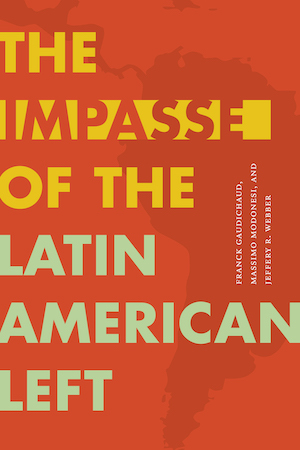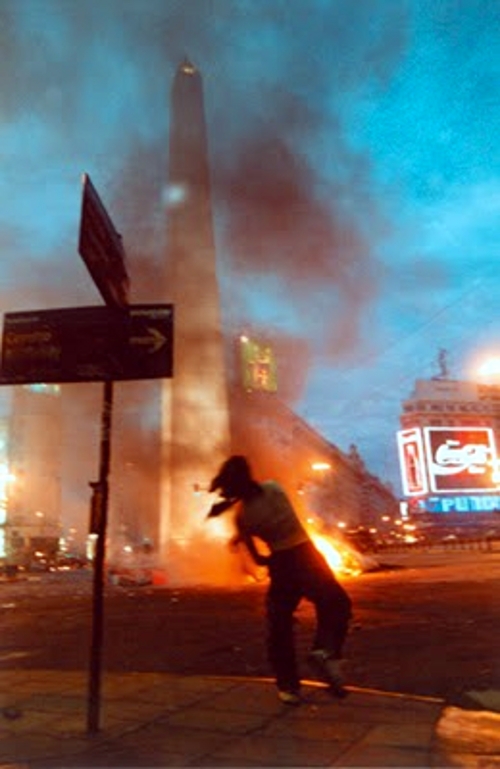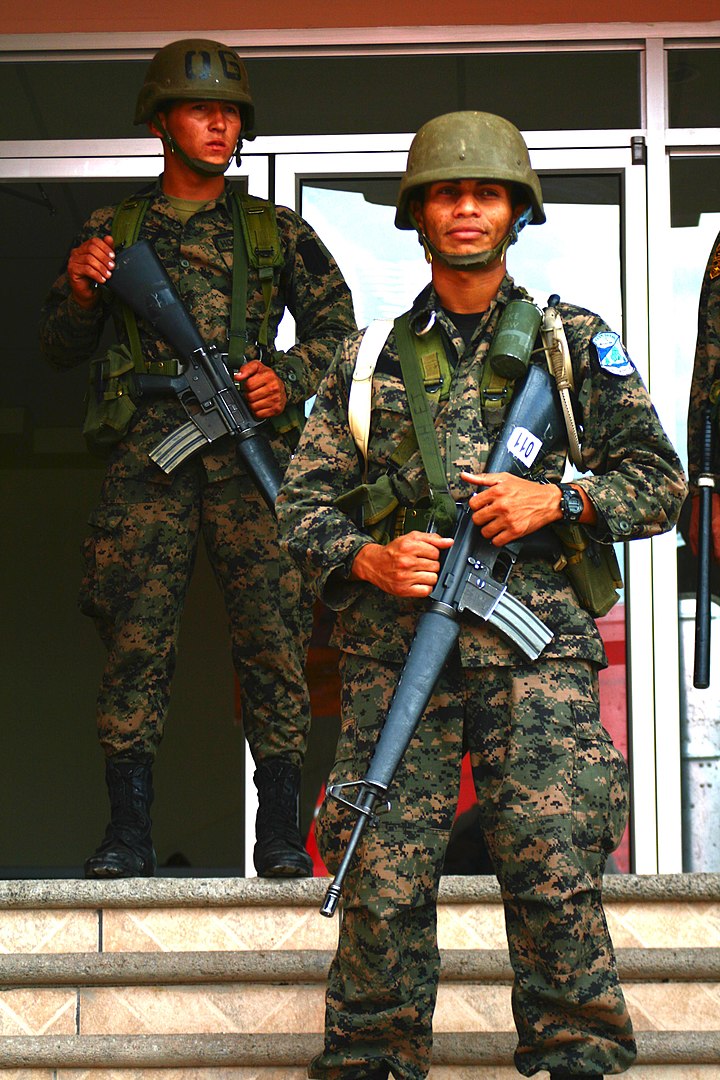The rise and fall of progressivism in Latin America
Review of The Impasse of the Latin American Left

The Impasse of the Latin American Left
by Frank Gaudichaud, Massimo Modones, and Jeffery R. Webber
Duke University Press, 2022

If you were to look at a map of South America in the mid-1990s, it would be dominated by right and center-right neoliberal governments. By the mid-2000s the electoral map had been fundamentally reconfigured. Left and center-left governments were in power in nearly every South American nation. By 2019 many of these left and center-left governments had been overthrown or defeated electorally, or had moved to the right politically. How do we understand this shift and what lessons should we draw from this cycle? The Impasse of the Latin American Left is a timely and urgent book that is essential to understanding the recent twists and turns of the fortunes of the left in Latin American.
Guadichaud, Modonesi, and Webber argue that there are severe limitations to political change and reform without genuine transformations of class structures and social relations of production. In a context of deep global crises, these crucial lessons are not only relevant to Latin America, including understanding recent center-left electoral victories, but offer important lessons for popular struggles and the left across the globe.
The Impasse develops a persuasive, systematic periodization of complex relations between class struggles, progressivisms, the left, and popular movements from the 1990s to the present. The book sucessfully gives coherence to the chaotic processes of historical change across the region.
In three substantive chapters, written individually, the book makes interrelated arguments that move through three levels of analysis—the political, the economic, and the ideological. Together these arguments paint a picture of what the authors call “progressivism in twenty-first century Latin America.”
Popular movements and progressive politics
The first argument of the book is that the era of Latin American progressivism in the twenty-first century was made possible by the preceding period of “plebian” upsurge in the 1990s. These popular rebellions were fueled by a multitude of social movements. (Gaudichaud describes these uprisings as plebeian because they were not all strictly proletarian, involving unemployed workers in Argentina, for example. Nor were they completely popular, since the middle classes were also integrated into the struggles in some places.)
The period that preceded and led to these plebeian uprisings was marked by neoliberal hegemony. Neoliberalism became the predominant economic philosophy in Latin America in the 1980s and hit its peak in the 1990s. Privatization, trade liberalization, austerity, deregulation, and wage cuts, often through structural adjustment programs pushed by the International Monetary Fund (IMF) and the World Bank, became the “common sense” recipe for economic development. The decades of the 1980s and 1990s, often labeled, respectively, “the lost decade” and “the long night of neoliberalism,” were a disaster for the majority of Latin Americans. The Impasse explains that between 1980 and 2003 the unemployment rate rose from 7.2 percent to 11 percent, poverty shot up from 40.5 percent to 44 percent, the minimum wage fell by an average of 25 percent, and informal employment rose from 36 percent to 46 percent, all while gross domestic product (GDP) stagnated and debts soared. In absolute terms this means that 84 million more people entered poverty between 1980 and 2002.
It is no surprise, then, thata general rejection of both the Washington Consensus of economic policy pushed by the United States and sections of international capital—and the domestic political caste that was unable or unwilling to move beyond neoliberalism and chart a different path—was simmering among the Latin American masses. By the end of the 1990s, popular struggles rejecting neoliberalism took center stage. Social movements contested prominent neoliberal measures through riots, strikes, roadblocks, factory takeovers, land occupations, and myriad other forms of collective action, beginning what Gaudichaud calls a “long wave of the Latin American class struggle.” These movements developed from what started out as defensive protest mobilizations into more offensive mobilizations that experimented in alternatives to neoliberal development.

Gaudichaud, borrowing from Argentine Marxist Claudio Katz, identifies “four great popular rebellions.” The first was the Caracazo in Venezuela in 1989. The Venezuelan people, most of them living in poor neighborhoods, revolted against the brutal implementation of neoliberal IMF measures, including a reduction of fuel subsidies and the increase of public transportation fares by 30 percent by President Carlos Andres Perez. The government response to the uprisings was violent, resulting in more than 1,000 deaths in just the first four days.
The second major uprising was the massive indigenous popular rebellions in Ecuador in 1994, largely organized by the Confederation of Indigenous Nationalities of Ecuador (CONAIE). From 1996 to 2005, this indigenous movement and its allies, through massive mobilizations and street clashes, brought down three governments (Abdalá Bucaram in 1997, Jamil Mahuad in 2000, and Lucio Gutiérrez in 2005).
The third major insurrection of this period was the piquetero movement in Argentina. Neoliberal policies led to the country’s economic collapse in December 2001, which left more than half of those in greater Buenos Aires below the poverty line. Wages were drastically reduced, unemployment shot through the roof, and the country faced a severe liquidity crisis. Thousands of impoverished and unemployed Argentines—more than 70 percent of them women—responded by taking it to the streets and blocking roads with pickets. Like the uprisings in Ecuador, these rebellions were able to force out several Argentine presidents in just a few short years (from 2001-2003). But these insurrections didn’t just bring down several presidents, they also developed new forms of collective action, including creating unemployed workers’ unions, neighborhood assemblies, self-managed daycare centers and cultural centers, and recuperation of bankrupt factories, which were then operated under workers’ control.
The fourth popular rebellion, which took place in Bolivia, was the deepest and most radical explosion of all the plebian uprisings. In 2000 popular movements in Cochabamba beat back an IMF prescribed privatization of the public water company. A large private conglomerate led by US multinational Bechtel Corporation was poised to win a forty-year contract to control Bolivia’s water. After six months of struggles, at the cost of severe repression, the movement won the “water war,” reversed the privatization, and expelled the company from the country. A second water war broke out in 2005 in El Alto, which also succeeded in reversing the government’s plan to privatize water. Between 2003–2005 massive uprisings broke out again in what were called the “gas wars,” in response to the government’s plan to privatize gas.
The resistance of these movements facilitated the onset of the progressive cycle in Latin America. By the early 2000s, this upsurge of popular rebellions had fractured neoliberal hegemony and the Washington Consensus in the region. In three out of these four (Argentina, Bolivia and Ecuador) the uprisings were able to force out several presidents in their respective countries. This crisis of neoliberalism eventually found formal political expression in an electoral turn to the left in the region, often called the Pink Tide. The electoral map of right and center-right governments was fundamentally reconfigured by various left and center-left electoral victories (Hugo Chávez in Venezuela in 1998, Néstor Kirchner in Argentina in 2003, Luiz Inácio Lula da Silva in Brazil in 2003, Tabaré Vázquez in Uruguay in 2004, Evo Morales in Bolivia in 2006, Manuel Zelaya in Honduras in 2006, Michelle Bachelet in Chile in 2006, Rafael Correa in Ecuador 2007, Daniel Ortega in Nicaragua in 2007, Fernando Lugo in Paraguay in 2008). This “tide” was brought forth and made possible by massive popular uprisings that preceded them. The popular rebellions fueled by social movements created the conditions for left and center-left victories at the voting booth.
The political economy of the Latin American left
Chapter two, the strongest and most persuasive chapter, takes up the book’s second argument. In his contribution, Webber contends that, while left and center-left governments were able to achieve hegemonic rule between 2006–2013, they were unable to translate their political momentum into a transformation of class structures or improvement of Latin America’s subordinate position within the international division of labor. In some respects, the latter worsened as many progressive governments moved away from industrialization and toward an economy based on primary exports.
In most cases the first steps taken by progressive governments in the Pink Tide were marked by state-driven economic policy and redistributive policies, largely funded by very high raw materials prices, export revenues, and a favorable economic context. During this period there was a steady increase in public spending on social needs. Countries with progressive governments also implemented policies that improved infrastructure, workers’ rights, agrarian reforms, nationalizations of key resources, and advances in participatory democracy.
Overall, measurable improvements were seen in living conditions for popular sectors of society. These progressive governments and their redistributive policies lifted, within a decade, more than 70 million people out of poverty. Webber points out that 22.6 percent of Latin Americans were destitute and 48.4 percent of them were poor in 1990. By 2004 these figures were 12 percent and 28 percent, respectively. These results were most pronounced in the countries of the “left turn.” In Bolivia poverty fell from 66.4 percent in 2005 to 39.3 percent in 2014. In Ecuador the poverty rate dropped from 37.6 percent in 2006 to 22.5 percent in 2014. In Venezuela the results were the most dramatic. Between 1998–2011 Venezuela was the single country that did the best in reducing inequality (the GINI coefficient fell from 0.486 to 0.390), while reducing poverty by 10 points and extreme poverty by 14 points.
Despite these advances and despite implementing policies that contradicted some of the most egregious tenets of neoliberalism, progressive governments did not alter the fundamental social relations of production nor Latin America’s subordinate position in the global economy, however.
This high period of progressivism coincided with a commodities boom between 2003–2011, and the accompanying intensification of extractive capitalism in the region partially accounted for the high rates of economic growth and increases in state revenues. The boom was driven by demand from emerging markets like China and India. The price of commodities such as soy, iron ore, copper, and most importantly oil reached new highs, and accounted for much of the upturn in economic growth. The commodity boom enabled progressive governments to increase spending on social programs and reduce poverty and inequality, among other things, while leaving the ruling class’s economic power largely untouched. Millions were lifted out of poverty without the capitalist class being confronted in any significant way.
In some instances, notably in the financial and extractive industries, the economic power of capital was even strengthened. Big capital in general was able to profit from the progressive golden age. In Ecuador, for example, the country’s 300 largest companies concentrated 43 percent of GDP in 2006. By 2012 these companies accounted for 46 percent of GDP. During this time period, national wealth almost doubled, making clear just how much the capitalist class was able to profit from neo-developmentalist policies of the center-left Correa administration. The figures were similar for most of the Pink Tide governments. In other words, progressive governments were able to drastically increase social spending to benefit the masses, while avoiding and postponing important class questions, , such as altering social relations of production.
Eventually commodity prices would drop (in some cases precipitously) and important decisions—and class conflict—could no longer be postponed. Would progressive governments respond to decreases in state budgets due to the end of the commodity boom by implementing austerity measures and make workers pay for the crisis, or would they confront the capitalist class and fundamentally alter relations of production to make the capitalist class pay for the crisis? With disastrous consequences, governments across Latin America chose the former.
The relationship between popular movements, parties, the state, and progressive governments during this period was contradictory, and understanding this complexity is essential to understanding this period. Large sections of these movements were institutionalized and integrated into the apparatuses of the states led by these progressive governments. A considerable number of the leaders of these movements were co-opted and bureaucratized. The result of this was the defanging and demobilization of many of the movements that created the conditions for the rise of these progressive governments in the first place. In other words, because social movements had been integrated into the state, when crises hit, they were not well positioned to push for an alternative to the austerity that the ruling parties embraced. Progressive governments were committed to austerity because they had made social pacts with the capitalist class and became their accomplices when the correlation of forces had shifted. Much like their conservative counterparts, progressive governments now favored mining interests and agribusiness.
The period 2013–2020 is marked by the end of the commodities boom, the resulting economic and political crisis, the return of the neoliberal right, and a turn toward authoritarianism. The end of the progressive cycle and the return of the neoliberal right to power materialized in three ways. First, some of progressive governments were defeated electorally. This was the case in Argentina in 2015 and in Chile in 2018. Second, progressive governments were overthrown by right-wing coups (often backed by Washington). This was the case in Honduras in 2009, Paraguay in 2012, Brazil in 2016, and Bolivia in 2019. Third, progressive governments that survived electoral or extra-constitutional challenges to remain in power nonetheless moved quickly toward neoliberalism, austerity, and authoritarianism in response to the end of the commodity boom and declining state revenues.
Two examples of this are Nicaragua under Ortega and Venezuela under Nicolás Maduro. In Venezuela, Chávez died in 2013; his party, the PSUV (the United Socialist Party of Venezuela), lost the midterm elections in 2015, and his successor, Maduro, moved politically and economically to the right, despite using the rhetoric of the left. Maduro remained in power but made concessions to both domestic and foreign capital.

A whole series of former ministers and generals who were comrades of Chavez are today very critical of Madurismo. These critics are treated by the Maduro government as pariahs or even arrested under suspicion of collusion with “the enemy.” Maduro also created Special Economic Zones, which exempt companies from respecting social and environmental rights. He also launched the Arco Minero del Orinoco project, which awarded major concessions to multinational corporations covering a territory that represents 12 percent of national territory for mineral exploitation.
In Nicaragua, Ortega also moved drastically to the right. He negotiated free trade deals with the United States, also created Special Economic Zones, and made strong alliances with former counterrevolutionaries and the country’s conservative church. He also carried out massive state violence against demonstrations. Ortega has also maintained a stronghold over the executive, legislative, and judicial branches, and imprisoned many of his former Sandinista comrades, as well as opposition candidates.
But it wasn’t just Ortega and Maduro. Bachelet in Chile, the Workers’ Party in Brazil, and Morales in Bolivia, among others, moved rightward both politically and economically.
Webber argues that the waning of progressive hegemony in the region and the rapid rise of right-wing forces was made possible by retreats and conservative metamorphoses of the left in government.
The new right in power, Webber argues, has no real answers to the crises of the day. It lacks the coherent project of political rule and vision that defined the orthodox neoliberal right of the 1980s and 1990s. The international context has also changed drastically since the 1990s. The new right has insufficient ideological, economic, or political bearings to effectively navigate this new terrain.
While it is clear that the economic crisis in the region weakened the material base for progressive governments and opened up political opportunities for right-wing renewal, it also opened up political opportunities for U.S. imperialism.
At the beginning of the twenty-first century, progressive governments attempted various projects to forge deeper ties of Latin American integration as a counterweight to imperial forms of domination in the region. Some of these projects were radical in nature (ALBA, the Bank of the South), while others were more moderate (MERCOSUR, UNASUR, and CELAC). These South-South integration projects were, in part, able to weaken U.S. hegemony in Latin America.
But the momentum of these regional projects was halted with the collapse of the commodity boom and the consequent rise of the political right. Imperial powers and powerful capitalist states like the United States and China seized this opportunity to exert their influence in the region. Washington sought to take advantage of this crisis and reinsert itself in the region to defend its position as a global superpower. The United States backed parliamentary and military coups, implemented deadly sanctions (the harshest directed at Venezuela), increased its military presence (primarily in Colombia), pushed for bilateral trade agreements, and engaged in various destabilization efforts to reassert its dominance.
China, meanwhile, transformed itself into the primary line of credit to Latin American countries. China negotiated highly asymmetrical bilateral agreements, particularly in the areas of credit and investment. These asymmetrical agreements reinforced Latin America’s position as a primary commodity producer and led to increasing debt obligations. While offering better conditions than those typically offered by the IMF and World Bank, China’s loans are typically linked to extractivist projects in mining, energy, and other raw materials, which threaten to lock Latin America into its dependent position within global capitalism.
Latin American progressivism
The book’s third argument is that there was a shift from an overarching anti-neoliberal consensus in the 1990s to a much more complex field of debate among the critical Latin American left early in the twenty-first century. Chapter three gives a helpful brief overview and survey of the competing theoretical frameworks of the Latin American left grappling with the contemporary conjuncture. Within this context, Modonesi argues that the best lens to understand the intricacies of the era of Latin American progressivism is through Antonio Gramsci’s concept of “passive revolution.” Despite plebeian uprisings from below creating the conditions for the electoral victories of progressivism, Modonesi argues that, once in power, these passive revolutions were driven from above in ways that consolidated capitalist relations and reconstituted modes of capitalist accumulation in an effort to absorb and de-escalate class struggle from below. In other words, socioeconomic reforms were implemented that benefited the subaltern classes, but were designed in ways that demobilized them and allowed them to be controlled from above.
While far-reaching change has occurred in the ideological composition of those occupying the apparatuses of the state, this was not accompanied by a parallel transformation of the underlying property relations and class structures of these societies. In short, bourgeois capitalist social relations and the process of capitalist accumulation were consolidated through demobilization and cooptation of revolutionary forces. The progressive left in power participated in such passive revolutions not only through excluding the masses, but also through forms of symbolic reward and the institutionalization of social movements. Modonesi argues that this period had both transformative and restorative characteristics at different moments, but restoration not transformation won the day.
Conclusion
The Impasse of the Latin American Left is an important book that provides many lessons for social movements and radicals outside of Latin America. Through a thorough analysis of the progressive cycle in Latin America, The Impasse makes clear the severe limits of political change and reform without genuine transformations of class structures and social relations of production. In the absence of a genuine, fundamental change in relations of production, the limits of social change are severely truncated and remain vulnerable to the vagaries of international market forces. Postponing the central confrontation with the capitalist class comes with a severe cost. As Gaudichaud, Modonesi, and Webber argue: “The crisis of the progressive experience indicates, above all, that a project of social transformation can never be limited to ‘reforms from above’ along with a redeployment of the state based on a redistribution of raw materials revenues, the intensification of extractivism, and the embrace of destructive models of consumption. The end of the cycle also confirms that there are gigantic obstacles and difficulties to overcome.”
While Gaudichaud, Modonesi, and Webber argue that we have entered a period of right-wing advance and left-wing retreat, they also document significant signs of left renewal in the streets. In 2019 we saw rebellions in Chile, Colombia, Ecuador, and Puerto Rico. In addition to these rebellions, ecological and popular feminist movements are emerging as the most sustained expressions of extra-parliamentary class struggle in Latin America. The return of working-class mobilization bodes well for the possibility of left-wing recomposition and the renewal of class struggle from below.

Since The Impasse went to press, we have seen the resurgence of what some commentators are calling a “New Pink Tide,” where the center-left has come to power in several Latin American countries (Colombia, Peru, Chile, Honduras, Bolivia, Argentina, Mexico). The most recent examples, Gustavo Petro in Colombia and Gabrielle Boric in Chile, much like the first Pink Tide, were made possible by the massive popular uprisings that preceded them. Chile and Colombia both saw popular rebellions in late 2019. Colombia had even bigger, quasi-insurrectionary, demonstrations from April to October 2021. It was in this context that Petro launched his successful center-left challenge to Colombia’s right-wing, which had ruled the country for decades. Once again social discontent and extra-parliamentary challenges spilled over into institutional electoral politics. Confirming one of the central theses of The Impasse, it was massive plebeian uprisings that created the conditions for the electoral triumphs of both Petro and Boric.
But Despite these electoral victories, the thesis of The Impasse that the left is at an impasse remains true. Each of these center-left governments has already made big compromises with the right, accommodated capital, and adapted quickly to the center. Furthermore, these governments are far from enjoying the level of hegemony the old center-left held at the height of the commodities boom.
In order for these incipient struggles to succeed, it is imperative that we learn from the lessons of what went right and what went wrong from the last cycle of popular movements and their electoral expression. Until the central challenge of transforming the capitalist relations of production is taken up, the electoral expressions of uprisings, rebellions, and social mobilization will fall prey to the same pressures and traps that befell the earlier progressive efforts. The Impasse of the Latin American Left is an important contribution to the effort to learn from past struggles to chart a different course.
Categories
We want to hear what you think. Contact us at editors@tempestmag.org.
Anderson Bean View All
Anderson Bean is a North Carolina– based activist and author of the book Communes and the Venezuelan State: The Struggle for Participatory Democracy in a Time of Crisis from Lexington Books.
